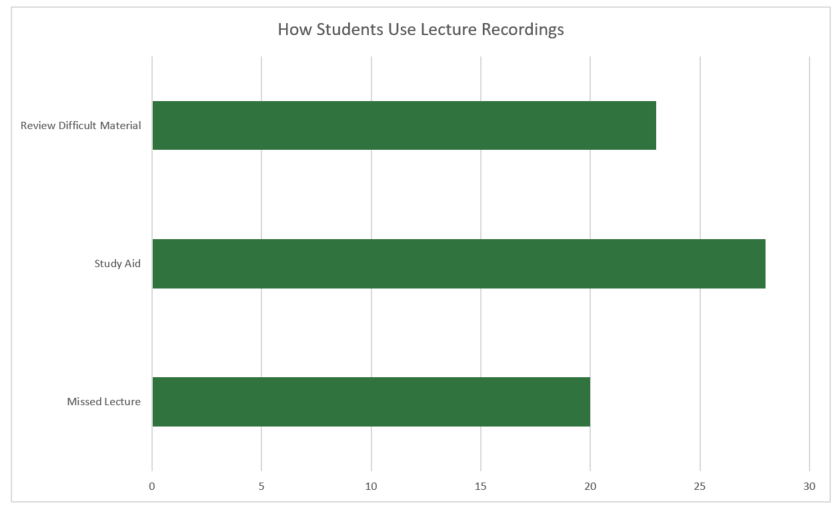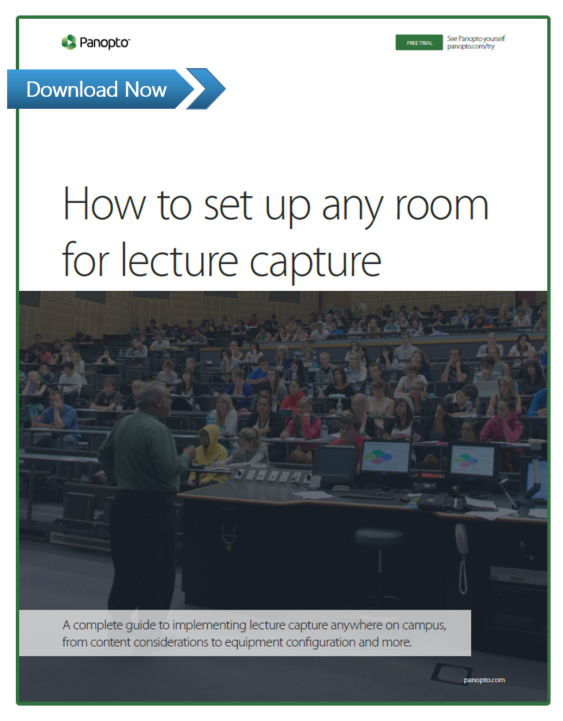- Academic Technology
75 Studies Reveal The Impact Of Lecture Capture

Lecture capture software has become cemented in the technology stack of nearly every educational institution today. More than 4 in 5 American colleges and universities now use lecture capture technology to some degree.
Yet while learning technologists, instructional designers, and administrators alike have largely embraced video-supported learning in order to enhance the student experience, there remain some educators still skeptical of lecture capture’s benefits. From the perceived potential for decreased attendance to whether or not such technology has a positive impact on student achievement, there have long been debates around the most common objections to lecture capture.
Anecdotes aside, we were curious what the data had to say about the impact of lecture capture. So we went digging. We uncovered 75 studies performed between 2003 and 2019 (all cited at the bottom of this post), and examined the meta-trends in prominent lecture capture research.
Of the 75 lecture capture studies:
- 34 included a review of the impact of lecture capture on attendance,
- 15 included measurement its effect on student achievement, and
- 51 included analysis of how students perceive lecture capture.
So: what has all that research found?
3 Big Trends From Over A Decade Of Lecture Capture Research
1. Lecture capture almost never negatively impacts attendance
Possibly the single most common objection to lecture capture is that if a video of the lecture is available, students won’t have a reason to actually attend class.
According to the data, however, faltering attendance is exceptionally uncommon.
Of the 34 studies that covered this topic, only four found that the availability of recorded lectures led to a decrease in attendance. Of those four, three reported the impact had been “slight” or “marginal”. Only one study reported a substantial negative impact.
The other 88% of available studies that measured attendance found that the availability of lecture capture had “little or no” negative impact. Notably, one of the studies to report this finding was a meta-analysis of 47 other research articles, further suggesting that the availability of recorded lectures is very unlikely to result in reduced attendance.
In short, students continue to see value in attending their courses in person, and with only a few exceptions, will continue to attend in person even when a recording of those courses is available.

2. The availability of recorded lectures is correlated with higher grades
Alongside student and/or faculty demand, many institutions that have adopted lecture capture have done so in order to provide students with a resource that may help improve their performance and achievement. At its most straightforward, the hope is that recording lectures will provide students with a much more detailed means to revisit what was discussed in any particular class session than could ever reasonably be captured in manual notes, and that being able to access that much more detailed resource to clarify questions when studying should help students do better on tests and earn higher grades.
So does it? While it’s important to point out that correlation doesn’t imply causation, the data does indicate that better student outcomes and lecture capture go hand-in-hand.
Of the 15 studies that measured the impact that making lecture recordings available for review had on student achievement:
- 10 found that the availability of lecture capture was correlated with higher grades,
- 4 found no correlation one way or the other, and
- 1 found that the availability of lecture capture negatively affected grades. Interestingly, this same study was the outlier mentioned in the section above that reported a substantial negative impact on attendance.
Of course, there are many reasonable explanations for why student performance is generally improved in classes where lecture capture is available. Faculty matter, and it may well be that faculty that are more likely to utilize available technologies are also more likely to find other creative ways to bolster performance. Dozens of other reasonable explanations no doubt exist as well.
But in so far as the subject has been studied, student performance and the availability of lecture recordings do appear to be positively aligned.

3. Students unanimously agree that lecture recordings are useful
It should be no surprise that students, on average, would report that having recordings of their lectures available for later review is useful to their studies. In general, students will always prefer having more materials and resources available for review than fewer.
But we also know from statistical research that unanimous results are a surprise. In any population there’s virtually always a holdout, a cynic, a critic.
Which is why is it perhaps surprising that of the 51 studies that explicitly addressed whether or not students found lecture recordings to be useful, every single one — all 51 studies — reported that students view lecture recordings to be a valuable resource.
So just how are students using lecture recordings? Actually, in a variety of ways:
- In 28 of the studies that examined how lecture recordings are used, students said they use them as a study aid
- 23 of the studies showed students use recorded lectures to review difficult material, and
- 20 showed them to also be helpful if a student missed a class.
Of course, as the math indicates above, those uses are not mutually exclusive. Students could and did report that recorded lectures served a number of valuable uses in their studies.

With almost every new study, the data only becomes more clear: recording lectures and making them available for students is a valuable service that students appreciate — one that has no detriment to traditional attendance and that may actually help improve student performance.
Ready To Provision More Of Your Classrooms For Lecture Capture?
 If you’re looking to expand the availability of lecture recordings to more courses, Panopto’s flexible lecture capture system makes it easy to scale lecture capture and provision any room on campus.
If you’re looking to expand the availability of lecture recordings to more courses, Panopto’s flexible lecture capture system makes it easy to scale lecture capture and provision any room on campus.
Download our Lecture Capture eBook to learn how, or contact us to request a free trial today.
Dive Into The Lecture Capture Data Yourself
Below you’ll find the complete list of lecture capture studies referenced in this analysis. Links are included where available.
| Study | Authors | Year |
| Lecture Capture in Engineering Classes: Bridging Gaps and Enhancing Learning | Al-Anashash & Gunn | 2013 |
| Does lecture capturing impact student performance and attendance in an introductory accounting course? | Aldamen, Al-Esmail, Hollindale | 2015 |
| Lecture Capture at Newcastle University | Ansell, Summerside | 2013 |
| Student Use of Recorded Lectures | Karnad | 2013 |
| Panopto Lecture Capture Pilot Study | Bagby | 2011 |
| Audio recordings of lectures as an e-learning resource | Balfour | 2006 |
| Effects of Lecture Capture on a Large First-Year Engineering Course | Bazylak, McCahan, Weiss | 2012 |
| Impact of Online Lecture Capture on Student Outcomes in a Therapeutics Course | Bollmeir | 2010 |
| Enabling a Comprehensive Teaching Strategy: Video Lectures | Brecht & Ogilby | 2008 |
| Explorations in course-casting: Podcasts in higher education | Bryans Bongey, Cizadlo, Kalnbach | 2006 |
| Creating opportunities for students in large cohorts to reflect in and on-practice | Cooner | 2010 |
| Lecture capture at Aberystwyth University | Davies, Hagen | 2011 |
| Lecture capture: making the most of face to face learning | Davis | 2009 |
| Lecture Capture: Student Opinion and Implementation Strategy | DeAngelis | 2009 |
| Staff and student views of lecture capture: a qualitative study | Dommett, Gardner, van Tilburg | 2019 |
| Lecture streaming: Getting the pedagogy right. | Donnan, Kiley, McCormack | 2004 |
| A study exploring the impact of lecture capture availability and lecture capture usage on student attendance and attainment | Edwards, Clinton | 2018 |
| Evaluating the use of lecture capture using a revealed preference approach | Elliott & Neal | 2015 |
| Use of Lecture Recordings in Medical Education | Franklin | 2011 |
| Using Video Lecture Capture systems to enhance teaching in high DFW courses at WSSU | Galvis, Kump, Overholt, Adams | 2010 |
| Alternative learning technologies for students with special educational needs. | Giliberti | 2012 |
| Student test scores are improved in a virtual learning environment | Goldberg & McKhann | 2000 |
| Students and recorded lectures: survey on current use and demands for higher education. | Gorissen | 2012 |
| The Impact of Web-Based Lecture Technologies on Current and Future Practices in Learning and Teaching | Gosper | 2008 |
| The New Imperative for Lecture Capture Systems in Higher Education | Greenberg & Nilssen | 2009 |
| Examining the Use of Lecture Capture Technology: Implications for Teaching and Learning | Groen | 2016 |
| Profcasts and Class Attendance – Does Year in Program Matter | Holbrook & Dupont | 2009 |
| What is the academic efficacy of podcasting | Heilesen | 2010 |
| If You Post It, Will They Come? Lecture Availability in Introductory Psychology | Hove & Corcoran | 2008 |
| Medical Students’ Perception of the Usage of Lecture Recording Software | Hussain, Tabrez, Basu, D’Silva | 2018 |
| Individual differences in students’ use of optional learning resources | Inglis | 2011 |
| “But they won’t come to lectures…” The Impact of Audio Recorded Lectures on Student Experience and Attendance | Larkin | 2010 |
| Delivery of e-Lectures | Lavelle | 2006 |
| Promoting understanding using a virtual learning environment | Law | 2005 |
| Evaluating the use and impact of lecture recording in undergraduates | Leadbeater | 2013 |
| Does digital scholarship through online lectures affect student learning? | Kinash | 2015 |
| An emerging mobile learning tool in nursing education and students’ satisfaction. | Maag | 2006 |
| You, me and iLecture | McElroy & Blount | 2006 |
| A Review of Podcasting in Higher Education: Its Influence on the Traditional Lecture | McGarr | 2009 |
| How video lecture capture affects student engagement in a higher education computer programming course: A study of attendance, video viewing behaviours and student attitude | Mcgowan & Hanna | 2015 |
| Video Lecture Capture Technology Helps Students Study without Affecting Attendance in Large Microbiology Lecture Courses | McLean, Suchman | 2016 |
| Lecture recordings to support learning: A contested space between students and teachers | Morris, Swinnerton, Coop | 2018 |
| A three year case study of using audio to blend the engineer’s learning environment | Nortcliffe & Middleton | 2008 |
| Turn up, tune in, don’t drop out: The relationship between lecture attendance, use of lecture recordings, and achievement in different levels of study | Nordmann, Calder, Bishop, Irwin, Comber | 2017 |
| Lecture Capture in Higher Education: Time to Learn from the Learners | Nordmann, McGeorge | 2018 |
| The Use of Lecture Recordings in Higher Education: A Review of Institutional, Student, and Lecturer Issues | O’Callaghan, Neumann, Jones, Creed | 2017 |
| Learning analytics and study behaviour : A pilot study | Phillips | 2011 |
| Using academic analytic tools to investigate studying behaviours in technology-supported learning environments | Phillips | 2010 |
| Evaluation of Student Engagement with a Lecture Capture System | Pons, Walker, Hollis, Thomas | 2012 |
| Lecture capture: Current research and future directions. | Pursel & Fang | 2012 |
| Using student generated audio to enhance learning | Rossiter, Nortcliffe, Griffin, and Middleton | 2009 |
| Does streaming of a lecture result in empty seats? | Russell & Mattick | 2005 |
| Exploring the Role of Videos in Medical Education Curriculum: A Two Year Study in Cardiothoracic Anatomy | Sajan, Torre, Caceres, Laurance, Marquez | 2019 |
| Live lecture versus video podcast in undergraduate medical education | Schreiber | 2010 |
| Lecture capture: rich and strange, or a dark art? | Secker, Bond, Grussendorf | 2010 |
| Does lecture capture make a difference for students in traditional classrooms | Settle | 2011 |
| Why don’t students attend lectures and what can be done about it through using iPod nanos? | Shannon | 2006 |
| Non‐native english language speakers benefit most from the use of lecture capture in medical school | Shaw & Molnar | 2011 |
| Evaluation of modes of electronic delivery of construction management courses | Sher & Gajendran | 2008 |
| An exploration into the reactions of undergraduate students to virtual lectures. | Signor | 2003 |
| Impact of video recorded lectures among students | Soong | 2006 |
| Use of lecture recordings on attendance and achievement | Spittaels & Vanacker | 2019 |
| Video lecture capture (VLC) system: A comparison of student versus faculty perceptions | Toppin | 2010 |
| Impact of Class Lecture Webcasting on Attendance and Learning | Traphagan | 2010 |
| Podcasting, student learning, and expectations | Tynan & Colbran | 2006 |
| Insights regarding undergraduate preference for lecture capture | Veeramani & Bradley | 2008 |
| Lecture attendance and web based lecture technologies : A comparison of student perceptions and usage patterns | Von Konsky | 2009 |
| Podcasting in education: Are students as ready and eager as we think they are? | Walls | 2010 |
| Evaluating Student Use Patterns of Streaming Video Lecture Capture in a Large Undergraduate Classroom | Whitley-Grassi | 2017 |
| Lecture Capture – The Early Qatar Experience | Wilbur, Jewesson | 2010 |
| The Lectopia service and students with disabilities | Williams | 2006 |
| Lecture recordings: extending access for students with disabilities | Williams & Fardon | 2007 |
| On-demand internet-transmitted lecture recordings: attempting to enhance and support the lecture experience. | Williams & Fardon | 2005 |
| Use of Lecture Capture in Undergraduate Biological Science Education | Wiese & Newton | 2013 |
| Web‐based lecture technologies: blurring the boundaries between face‐to‐face and distance learning | Woo | 2008 |



